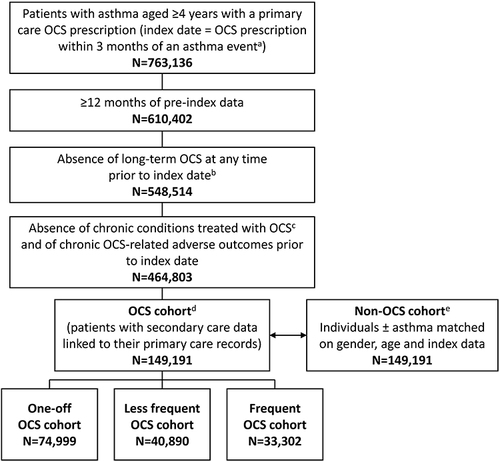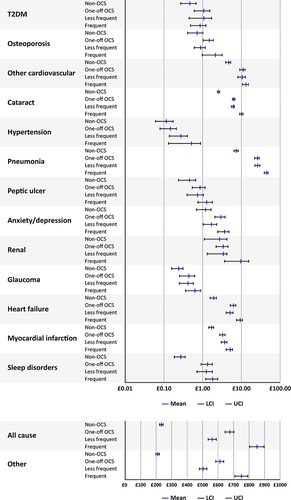Figures & data
Figure 1 Study population selection from the UK CPRD database. aAsthma events included prescription for asthma medication, asthma review or asthma diagnosis. bThe methodology for determining whether patients received intermittent or long-term OCS is described in detail in a prior publication.Citation11 cConditions included ankylosing spondylitis, Sjogren’s syndrome, systemic lupus erythematosus, temporal arteritis, ulcerative colitis, psoriatic arthritis, multiple sclerosis, polymyalgia rheumatica, Crohn’s disease and cancer of the respiratory system. dThe OCS cohort was grouped by OCS prescription patterns: one-off, defined as a single OCS prescription; less frequent, defined as >1 prescription with any gaps ≥90 days but no gap <90 days; and frequent, defined as >1 prescription with <90-day gap(s). eThe non-OCS cohort was defined as the absence of any OCS prescription at any time pre-index, and the index date was the date of the GP visit nearest to the index date of matched OCS patient.

Table 1 Baseline Demographic and Clinical Characteristics of UK Patients with Asthma Receiving Intermittent OCS and Matched Non-OCS Individuals (with or without Asthma)
Table 2 Non-Respiratory-Related and All-Cause and Annualized HCRU (HCRU Events/Patient-Year) for UK Patients in the Intermittent OCS Cohort, Intermittent OCS Subgroups and Non-OCS Cohort During the Entire Follow-Up Period
Table 3 Adjusted IRRsa for Non-Respiratory-Related and All-Cause Annualized HCRU for UK Patients According to Intermittent OCS Prescribing Pattern
Figure 2 Mean non-respiratory healthcare costs in the UK per patient (A); Mean non-respiratory healthcare costs in the UK per patient per year (B); Mean all-cause healthcare costs in the UK per patient (C); Mean all-cause healthcare costs in the UK per patient per year (D). The Any intermittent OCS group includes any patient who received intermittent OCS and includes all patients who received one-off OCS, less frequent OCS, and frequent OCS. 2020 British pounds [£] by HCRU categories and OCS use status.
![Figure 2 Mean non-respiratory healthcare costs in the UK per patient (A); Mean non-respiratory healthcare costs in the UK per patient per year (B); Mean all-cause healthcare costs in the UK per patient (C); Mean all-cause healthcare costs in the UK per patient per year (D). The Any intermittent OCS group includes any patient who received intermittent OCS and includes all patients who received one-off OCS, less frequent OCS, and frequent OCS. 2020 British pounds [£] by HCRU categories and OCS use status.](/cms/asset/22ba6ac7-b3bd-49d4-91d2-d983e0d11b5b/djaa_a_12303788_f0002_c.jpg)
Figure 3 Total annualized costs of oral corticosteroid-related adverse outcomes identified from hospital admissions. “Other” refers to ICD-10 codes not specified for this analysis (see Table S1 for specified events) and comprised 36,877/37,668 (97.9%) inpatients in the intermittent OCS cohort and 16,109/16,506 (97.6%) inpatients in the non-OCS cohort. Costs are in 2020 British pounds (₤). x-axes are logarithmic except for All cause and Other.

Data Sharing Statement
The dataset supporting the conclusions of this article was derived from the Optimum Patient Care Research Database (www.opcrd.co.uk). The authors do not have permission to give public access to the study dataset; researchers may request access to OPCRD data for their own purposes. Access to OCPRD can be made via the OCPRD website (https://opcrd.co.uk/our-database/data-requests/) or via the enquiries Email [email protected].
